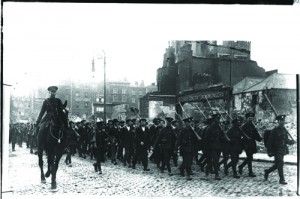The Military Service Pensions Collection
Published in Features, Issue 3 (May/June 2014), Volume 22The Military Service Pensions Collection originated in a decision of the Oireachtas, in June 1923, to compensate wounded members of the IRA, National Army, Irish Volunteers and Irish Citizen Army, amongst others, along with the dependants of deceased members of these organisations. The various Army Pensions Acts passed, 1923 to 1980, and the Military Service Pensions Acts, 1924–1964, gradually extended and updated the scope and range of the collection far beyond its original remit, to include virtually all organisations involved in the struggle for independence, such as the obscure ‘Hibernian Rifles’, a militia founded after a split in the AOH in the US, 30 members of which fought in the GPO during the Rising. Indeed, by 1936 even those members of the Connaught Rangers who had mutinied in protest at British policy in Ireland whilst on service in India in 1920 were deemed eligible for pensions.

Prisoners being escorted to the North Wall after the 1916 Easter Rising. Records and documents relating to the Rising are contained in a series of files catalogued under ‘Membership and Organization’, including IRA Nominal Rolls and reports by Cumann na mBan, Na Fianna Éireann and the Irish Citizen Army. (NMI)
The collection led an itinerant existence, being stored in Griffith Barracks (now Griffith College) on Dublin’s South Circular Road, then in Glasnevin in north Dublin and Renmore Barracks in Galway before finally, in 1989, ending up in Cathal Brugha Barracks in Rathmines, not too far away from their original home. The project to release the pension files was first announced by former taoiseach Bertie Ahern in 2006; steering and advisory committees were subsequently established to navigate a way through the c. 300,000 files in the collection. All relevant files had been handed over to the project by March 2008.
The ‘irregular’ nature of many of the organisations involved meant that the increasingly specific definitions of ‘active service’ had to be adopted, lest the system be abused. As W.T. Cosgrave put it in the Dáil, the original 1924 act ‘does not intend that there should be any soft pensions’. For example, in 1924 the Board of Assessors stated that it would not accept any application for service during Easter Week 1916 unless the application related to activity in Dublin (city and county), along with counties Galway, Louth, Meath and Wexford. Joining an organisation was not enough: applicants had to prove that they had taken part in military activities. The precise criteria had to be refined; in certain cases, activities in the anti-Treaty IRA during the Civil War could be taken as service. Equally, the origi-nal requirement that active involvement in fighting against British forces be the bottom line had to be altered: activities that were deemed risky and essential to the fighting (such as intelligence work) had to be included as well. Applicants who had endured, as one 1924 definition put it, ‘corresponding risks and sacrifices’ to those who had engaged in military actions were not to be left out in the cold.
But the significance of the collection arises from three key distinctions that set it apart from the Bureau of Military History (BMH): far more people applied for pensions than gave BMH statements, they did so at a much shorter remove—in the 1920s and 1930s—and, crucially, their claims had to be verified. It is the latter that makes the Military Service Pensions Collection so potentially useful.
John Gibney is on-line editor of History Ireland and content manager of the official Decade of Centenaries website: www.decadeofcentenaries.com.
















